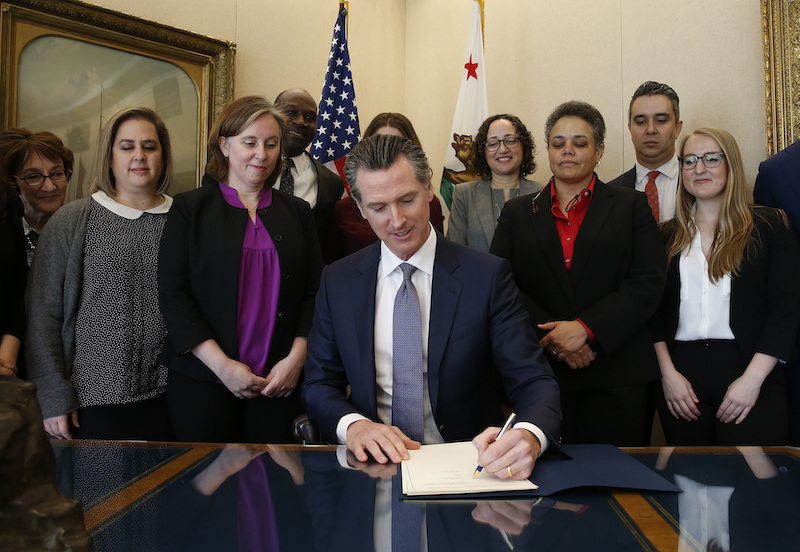Death Penalty Debate Takes a Turn Toward Sanity
California’s governor hasn’t solved all the capital punishment system’s ills, but he has given its opponents cause for celebration. California Gov. Gavin Newsom signs the executive order placing a moratorium on the death penalty. (Rich Pedroncelli / AP)
California Gov. Gavin Newsom signs the executive order placing a moratorium on the death penalty. (Rich Pedroncelli / AP)
When news broke Tuesday night that California Gov. Gavin Newsom had decided to sign an executive order imposing a moratorium on the death penalty in the Golden State, I was staggered. My heart pounded, and my mind raced back to all the years I spent as a young attorney representing defendants in capital cases—a physically exhausting and emotionally draining task, and one that, at times, seemed utterly futile.
Now that the order has been signed and I’ve had an opportunity to review it, I’m stunned by the scope and honesty of the governor’s action. Not only does it grant reprieves to the state’s 737 death row inmates, it repeals the state’s lethal-injection protocol and will close the infamous execution chamber at San Quentin State Prison.
The reasoning Newsom offered for his decision is especially compelling. “The intentional killing of another person is wrong and as Governor, I will not oversee the execution of any individual,” he said in a press release issued by his office. “Our death penalty system has been, by all measures, a failure. It has discriminated against defendants who are mentally ill, black and brown, or can’t afford expensive legal representation. It has provided no public safety benefit or value as a deterrent. It has wasted billions of taxpayer dollars. Most of all, the death penalty is absolute. It’s irreversible and irreparable in the event of human error.”
I still have two former clients housed at San Quentin’s death row. One, Ricardo Rene Sanders, has been there for over 36 years, tying him for the dubious honor of having the fourth-longest tenure among California’s condemned population.
In many ways, Sanders’ case epitomizes what’s arbitrary, wrong and evil about the death penalty. Sanders and two codefendants were charged with staging a robbery and shooting four people to death at a Bob’s Big Boy restaurant in Los Angeles in 1980. One of the defendants pleaded guilty and received a life sentence with the possibility of parole. The other, tried separately from Sanders, was convicted but was given a sentence of life in prison without the possibility of parole.
Only Sanders was sentenced to death, even though no physical evidence, firearms or fingerprints were found connecting him to the crime. The appellate courts, both state and federal, upheld his conviction and sentence, even though evidence discovered post-conviction revealed that prosecutors had secretly secured the release of a notorious jailhouse informant and subsequently used him to romance and persuade a female shooting victim to identify Sanders at trial.
Sanders has always maintained his innocence. I stopped representing him in 1992, when I became a judge. Since then, he has been represented by Pasadena attorney Verna Wefald, who operates a solo practice on a shoestring budget. I’ve written about her before in this column, most recently when she won a dismissal in the case of Bobby Joe Maxwell, who spent nearly 40 years in prison for two murders he didn’t commit.
Wefald is one of the gems of the legal profession, ever determined and dogged, toiling away outside the limelight, perpetually underpaid with the meager stipends dispensed to court-appointed counsel for the indigent. With her options for further appeals dwindling, Wefald told me that she nearly cried when she learned of Newsom’s order. We agreed that it was time to celebrate.
Three other states—Oregon, Colorado and Pennsylvania—have governor-imposed moratoria on the death penalty, but none is as far-reaching or significant as Newsom’s decree. California has far and away the largest death row in the country. Florida, with 343 condemned inmates, sits in a distant second place. As of July 1, 2018, there were 2,738 inmates on death row nationally.
Beyond its sheer mathematical impact, Newsom’s order directly calls into question the penological underpinnings of capital punishment.
Under the rules of “guided discretion”—the name given to the version of capital punishment that the Supreme Court’s 1976 decision in Gregg v. Georgia found constitutional—juries in capital cases are given the task of balancing and weighing statutory aggravating and mitigating factors relating to the charged offense, as well as the defendant’s background and character, to determine which defendants convicted of murder should be sent to prison and which should be condemned to die. The system is designed to be rational and fair and to minimize the impact of emotion and bias in sentencing.
But the system has failed, notwithstanding subsequent efforts made by state legislatures across the country, as well as by Congress when it reinstated the federal death penalty in 1988, and by later court decisions aimed at achieving further refinements. The death penalty remains, essentially, what it has always been—a capricious, primitive, state-sanctioned practice marred by racial and class disparities, fueled by rage and grief rather than reason, stoked by political animus, and with no more deterrent effect than long-term imprisonment.
Black and brown defendants continue to be sentenced to death in disproportionately greater numbers than white offenders. The death penalty is also disproportionately meted out in cases involving white victims. Worst of all, according to the Death Penalty Information Center in Washington, D.C., at least 15 likely-innocent men have been executed in the U.S. since 1989.
To be clear, Newsom’s order has its limitations. It does not overturn any convictions, and it will not result in the release of anyone from prison. The reprieves it grants are temporary and will last only as long as Newsom remains in office.
As expected, Newsom’s order is generating severe blowback from hardcore proponents of the death penalty and fearmongering politicians, foremost among them President Donald Trump. Trump, who took out a full-page ad in four New York City papers in 1989 to call for the execution of five minority teenagers falsely accused of raping a white jogger in Central Park, sent out a tweet at 4:39 a.m. Wednesday condemning Newsom. The president wants to expand the death penalty.
The battle against capital punishment is far from over. It has, however, taken what may well prove to be a decisive turn with Newsom’s order, this time in the direction of our better angels.
Your support matters…Independent journalism is under threat and overshadowed by heavily funded mainstream media.
You can help level the playing field. Become a member.
Your tax-deductible contribution keeps us digging beneath the headlines to give you thought-provoking, investigative reporting and analysis that unearths what's really happening- without compromise.
Give today to support our courageous, independent journalists.








You need to be a supporter to comment.
There are currently no responses to this article.
Be the first to respond.